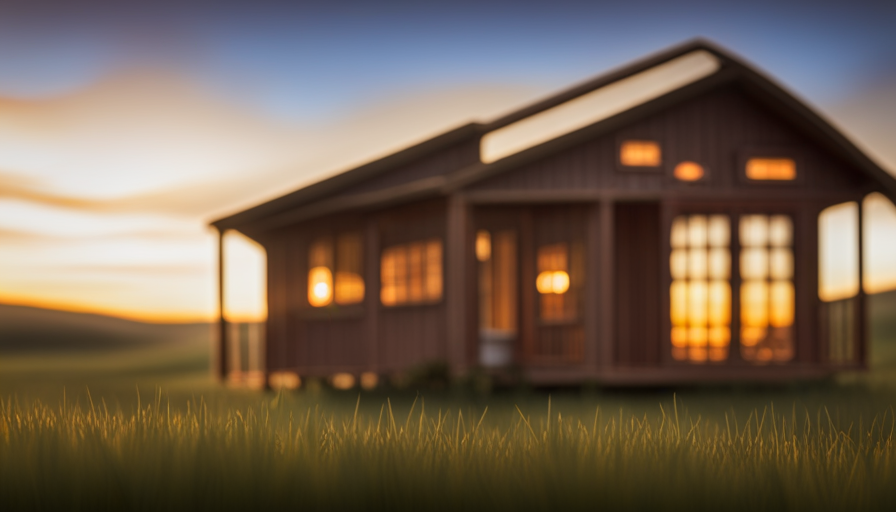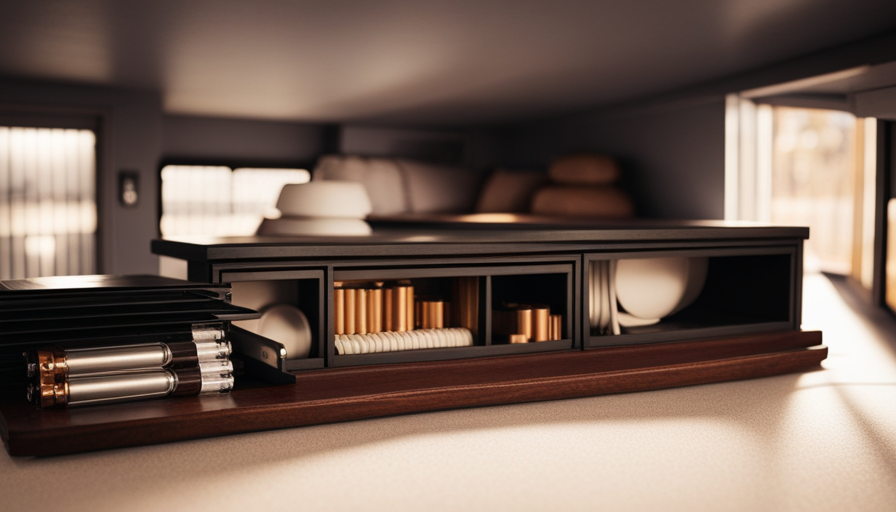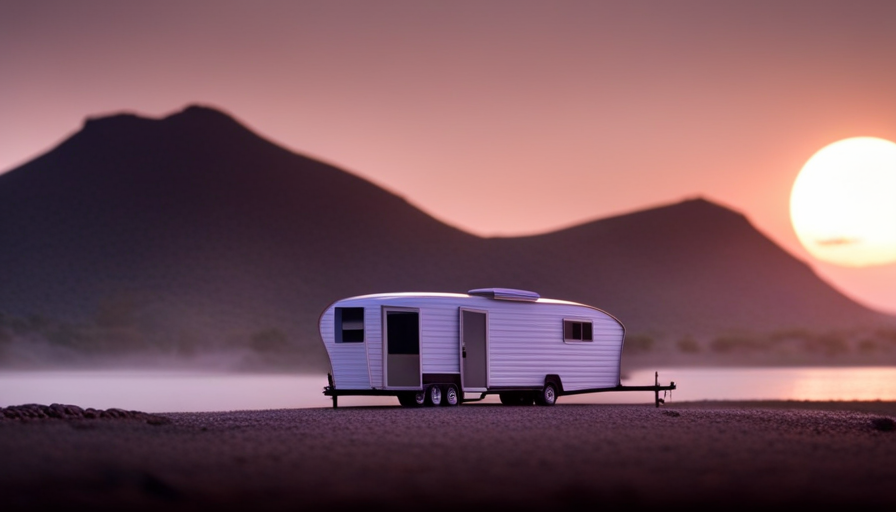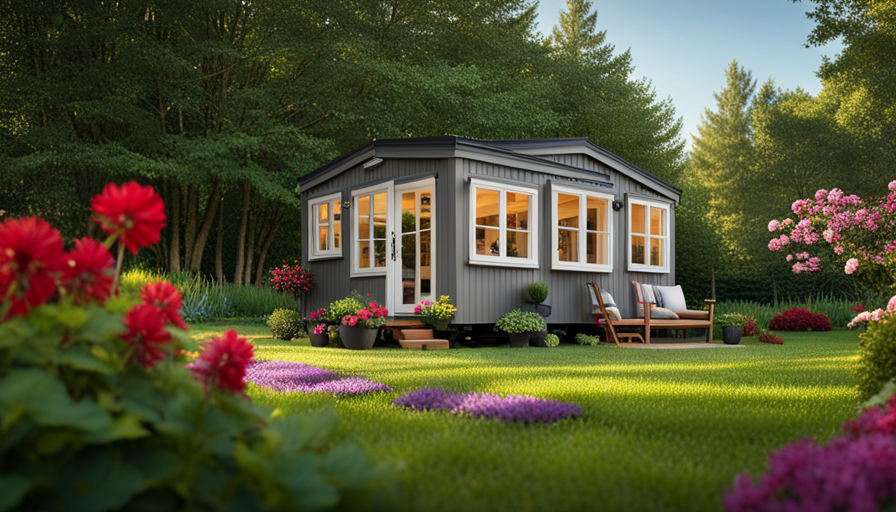Are you feeling tired of the constant rise in rent and mortgage expenses? Are you yearning for a simpler, more affordable way of life? You should consider joining the tiny house movement. These small homes offer a unique solution to the housing crisis, allowing individuals to live comfortably and sustainably, but in a smaller living space.
But just how much does a tiny house cost in the Lone Star State? Prepare to be amazed, as the prices may be smaller than you think. In this article, I will explore the factors that influence the cost of a tiny house in Texas, provide you with average cost estimates, and offer tips on finding affordable options. With real-life case studies and a thorough analysis of the pros and cons, we’ll help you decide if investing in a tiny house is the right choice for you.
So, let’s dive into the numbers and discover the true cost of tiny house living in Texas.
Key Takeaways
- The average cost of a tiny house in Texas ranges from $20,000 to $150,000 or more, with factors such as location, size, materials, and customization options influencing the cost.
- Financing options for tiny houses in Texas include builder financing, personal loans, RV loans, and home equity lines of credit.
- Additional costs to consider when purchasing a tiny house in Texas include land purchase or rental fees, utilities, permits, and ongoing maintenance costs.
- Customization options for tiny houses in Texas allow for personalization and maximizing space, while sustainable living practices can help reduce maintenance costs and lower utility bills.
Understanding the Basics of Tiny Houses
When it comes to comprehending the fundamentals of tiny houses, it’s essential to understand their basic features and characteristics. Tiny houses typically have an average size ranging from 100 to 400 square feet, making them significantly smaller than traditional homes. These compact dwellings are designed to maximize space efficiency and promote a minimalist lifestyle.
Additionally, tiny houses often feature multi-functional furniture and clever storage solutions to optimize the limited space available.
Zoning regulations also play a crucial role in understanding tiny houses. Different areas have varying rules and restrictions regarding the construction and placement of these small homes. Some cities and counties have specific zoning codes that allow for the establishment of tiny house communities, while others may have more stringent regulations or outright bans. It’s important to research and understand the local zoning regulations before embarking on the journey of building or purchasing a tiny house.
Factors that influence the cost of a tiny house in Texas include location, size, materials used, and customization options. These factors can significantly impact the overall cost of a tiny house, with prices ranging from $20,000 to $150,000 or more. Transitioning into the subsequent section about factors that influence the cost of a tiny house in Texas, it is crucial to consider these variables to make an informed decision.
Factors that Influence the Cost of a Tiny House in Texas
To determine the price of a tiny home in the Lone Star State, you’ll need to consider various factors that can significantly impact your budget. The average cost of a tiny house in Texas can vary greatly depending on these factors influencing the price. Here are three key considerations to keep in mind:
-
Location: The cost of land varies across Texas, and where you choose to place your tiny house can greatly affect the overall price. Urban areas tend to have higher land prices, while rural locations may offer more affordable options.
-
Size and Design: The size and design of your tiny house will also play a significant role in its cost. Larger tiny homes with more intricate designs and unique features will generally be more expensive. On the other hand, opting for a simpler layout and a smaller size can help keep costs down.
-
Materials and Construction: The choice of materials and construction methods can impact both the cost and quality of your tiny house. High-end materials and custom craftsmanship will increase the price, while more budget-friendly options can help you save money.
Considering these factors, it’s important to carefully evaluate your needs and preferences to determine the average cost of a tiny house in Texas that aligns with your budget.
Transitioning into the subsequent section about the average cost of tiny houses in Texas, it’s essential to delve deeper into specific price ranges and examples.
Average Cost of Tiny Houses in Texas
Considering the various factors that influence pricing, exploring the average cost of tiny homes in Texas reveals a range of affordable options for those seeking a cozy and sustainable living experience.
The average cost of a tiny house in Texas ranges from $30,000 to $150,000, depending on size, location, and amenities. Smaller, more basic models tend to fall on the lower end of the spectrum, while larger, more customized designs can reach the higher end.
When it comes to financing options, there are several routes to explore. Many tiny house builders offer financing plans, allowing buyers to pay in installments over a set period of time. Other potential avenues include personal loans, RV loans, or even utilizing a home equity line of credit. It’s important to thoroughly research and compare these options to find the best fit for individual circumstances.
As we delve into the subsequent section about additional costs to consider, it is crucial to understand that the average cost of a tiny house in Texas is just the starting point. There are various other expenses to factor in, such as land purchase or rental fees, utilities, permits, and ongoing maintenance costs.
Additional Costs to Consider
When considering the cost of a tiny house in Texas, it’s important to take into account additional expenses beyond the initial purchase price. These include utilities and off-grid systems, customization and interior design, as well as maintenance and upkeep.
Utilities and off-grid systems can vary greatly depending on the location and lifestyle choices, while customization and interior design costs will depend on personal preferences and desired features.
Lastly, maintenance and upkeep costs will be ongoing and should be factored into the overall budget.
Utilities and Off-Grid Systems
Although everything is bigger in Texas, the cost of utilities for a tiny house can be surprisingly low. Living off the grid is a popular choice for many tiny house owners in Texas, and it allows them to reduce their dependency on traditional utility services.
By utilizing renewable energy sources such as solar panels and wind turbines, tiny house owners in Texas can generate their own electricity and significantly lower their monthly utility bills. Additionally, implementing energy-efficient appliances and fixtures further reduces the consumption of electricity and water.
It’s important to note that the initial investment in off-grid systems can be higher, but the long-term savings and environmental benefits make it a worthwhile choice for many.
Moving on to customization and interior design, tiny house owners in Texas have endless possibilities to create their dream space within their compact living environment.
Customization and Interior Design
To truly make your tiny space your own, you can get creative with the customization and interior design of your compact Texas home. There are numerous customization options available to personalize your tiny house, from choosing the layout and materials to adding unique features and accents.
Many tiny house builders in Texas offer customizable options, allowing you to create a space that suits your specific needs and preferences. Additionally, space-saving techniques are essential in tiny house design. Maximizing storage space through built-in cabinets, lofted beds, and multipurpose furniture can help make the most of your limited square footage.
By utilizing these customization options and space-saving techniques, you can create a customized tiny house that reflects your style and maximizes functionality. This attention to detail and personalization will enhance your overall living experience and make your compact Texas home truly feel like home.
When it comes to maintenance and upkeep…
Maintenance and Upkeep
Take good care of your compact abode in the Lone Star State to ensure it remains a cozy and charming retreat for years to come. Maintenance costs for tiny houses in Texas can vary depending on factors such as size, materials used, and location. However, sustainable living practices can help reduce these costs in the long run. Regular maintenance tasks such as cleaning the gutters, inspecting the roof for leaks, and checking the plumbing can prevent expensive repairs down the line. Additionally, investing in energy-efficient appliances and insulation can lower utility bills and minimize the environmental impact. By incorporating these practices, you can not only save money but also contribute to a more sustainable lifestyle. Transitioning into the subsequent section about ‘tips for finding affordable tiny houses in Texas,’ it is important to consider various factors when searching for your dream tiny home.
Tips for Finding Affordable Tiny Houses in Texas
When it comes to finding affordable tiny houses in Texas, there are a few key tips that can help.
First, it’s important to research local builders and sellers to get an idea of the market and pricing.
Second, considering used or secondhand options can often lead to significant savings.
Finally, negotiating and comparing prices is crucial to ensure you’re getting the best deal possible.
By following these steps, you can increase your chances of finding an affordable tiny house in Texas.
Researching Local Builders and Sellers
While browsing for options, it’s fascinating to discover the variety of local builders and sellers of tiny houses in Texas. Researching local builders and sellers is an essential step in finding an affordable tiny house.
One aspect to consider is researching financing options available through these builders and sellers. Some may offer financing plans or connect you with lenders who specialize in tiny house financing.
Another important aspect is exploring zoning regulations in the area where you plan to build or place your tiny house. Different cities and counties in Texas may have different regulations regarding the size and location of tiny houses. It’s crucial to ensure that the builder or seller you choose is knowledgeable about these regulations and can guide you through the process.
Considering used or secondhand options can also be a cost-effective alternative.
Transitioning to the next section, exploring these options can help you find an even more affordable tiny house.
Considering Used or Secondhand Options
Exploring used or secondhand options can be a budget-friendly choice that adds a touch of charm and history to your dream home. When considering the used tiny house market, there are a few key things to keep in mind.
Firstly, research local listings and online platforms that specialize in selling pre-owned tiny houses. These platforms often have a wide variety of options to choose from, allowing you to find the perfect fit for your needs.
Secondly, consider financing options for used tiny houses. Some lenders may offer specific loans for pre-owned homes, making it easier to afford your dream tiny house.
Lastly, inspect the condition of the house thoroughly before making a purchase. Look for any signs of wear and tear, and consider hiring a professional inspector to ensure there are no hidden issues.
Transitioning into the subsequent section about negotiating and comparing prices, it’s important to have a clear understanding of the market value of used tiny houses.
Negotiating and Comparing Prices
Seek savvy solutions to skillfully secure a satisfyingly suitable price for your splendidly sought-after secondhand sanctuary. When negotiating the price of a used tiny house in Texas, it’s essential to employ effective techniques.
Start by researching the average market value of similar properties, taking into consideration factors such as size, condition, and location. This will provide you with a solid foundation for negotiation. Additionally, consider using price comparison websites to gather data on recent sales and current listings. These platforms offer valuable insights into the market trends and can help you determine a fair price range.
Remember to approach negotiations with a mindset of flexibility and open communication. By presenting your research and reasoning, you increase the likelihood of reaching a mutually beneficial agreement.
Transitioning to the next section about case studies: examples of tiny house costs in Texas, let’s explore real-life examples that showcase the range of prices in the state.
Case Studies: Examples of Tiny House Costs in Texas
In this discussion, I’ll provide three case studies that examine the cost of tiny houses in Texas. The first case study focuses on a tiny house in Austin. The second case study focuses on a tiny house in Houston. And the third case study focuses on a tiny house in Dallas. By analyzing these examples, we can gain a better understanding of the affordability of tiny houses in different cities within Texas.
Tiny House in Austin
Located in the heart of Austin, a tiny house offers a charming and cozy retreat from the bustling city life. In Austin, there are specific regulations that govern the construction and placement of tiny houses. These regulations, known as tiny house zoning, ensure that the houses adhere to safety standards and fit within the existing neighborhood aesthetic.
As of now, tiny houses in Austin are allowed as accessory dwelling units (ADUs) in certain areas, such as the backyard of an existing property. The cost of a tiny house in Austin can vary depending on factors such as size, amenities, and location. On average, the cost of a tiny house in Austin ranges from $50,000 to $100,000.
With the increasing popularity of tiny houses, it’s important for potential homeowners to navigate through the regulations and costs associated with building and living in a tiny house in Austin.
Moving on to the subsequent section about tiny houses in Houston…
Tiny House in Houston
If you’re considering living in a tiny house in Houston, you’ll be interested to know that the average price of a tiny house in the city is between $40,000 and $80,000, making it a more affordable option than traditional homes.
When it comes to tiny house regulations and zoning restrictions in Houston, it’s important to note that they vary depending on the specific neighborhood and local regulations. However, Houston has been known to be more lenient in terms of zoning for tiny houses compared to other cities. This flexibility allows individuals to explore the possibility of living in a tiny house without facing excessive restrictions.
Moving forward to the next section about tiny houses in Dallas, let’s delve into the unique aspects of this city’s tiny house scene.
Tiny House in Dallas
Explore the charm and affordability of Dallas’s tiny house community, where you can find unique and innovative living spaces. Dallas has embraced the tiny house movement and has implemented specific regulations and zoning laws to accommodate this growing trend. These regulations ensure that tiny houses are built safely and meet the necessary requirements for habitation. In Dallas, tiny houses are subject to the same building codes as traditional homes, ensuring that they’re structurally sound and equipped with necessary amenities.
The city also has designated areas where tiny houses can be placed, providing residents with the opportunity to live in a tight-knit community of like-minded individuals. With these regulations in place, investing in a tiny house in Dallas offers a promising prospect for those seeking an alternative, affordable living option in the city.
Transitioning into the subsequent section, let’s now explore the pros and cons of investing in a tiny house in Texas.
Pros and Cons of Investing in a Tiny House in Texas
When considering investing in a tiny house in Texas, it’s important to weigh the financial benefits, lifestyle considerations, and resale value and market trends.
From a financial standpoint, a tiny house can offer significant cost savings compared to traditional homes, with lower purchase prices, reduced utility bills, and potentially lower property taxes.
Lifestyle considerations include the ability to live a more minimalist and environmentally friendly lifestyle, while also enjoying the flexibility of mobility if desired.
Additionally, it’s essential to assess the resale value and market trends of tiny houses in Texas to ensure that it’s a wise long-term investment.
Financial Benefits
To fully appreciate the financial benefits, you should consider the long-term savings of owning a tiny house in Texas. When it comes to financial planning, investing in a tiny house can be a smart move. Here are a few cost-saving strategies to consider:
-
Reduced Utility Bills: One of the biggest advantages of a tiny house is its smaller size, which translates to lower energy consumption and reduced utility bills.
-
Minimal Maintenance Costs: With less square footage to maintain, tiny houses require less time and money for upkeep and repairs.
-
Lower Property Taxes: Tiny houses typically have lower property tax assessments compared to larger homes, resulting in additional savings.
Considering these financial benefits, owning a tiny house in Texas can provide long-term savings and financial stability. However, it’s important to also take lifestyle considerations into account, such as space limitations and the need for a minimalist lifestyle.
Lifestyle Considerations
Living in a tiny house in Texas offers a chance to embrace a simpler, more minimalist lifestyle. With the rising popularity of tiny homes, there are now more options for tiny house financing available in Texas. Many lenders offer specialized loans tailored to the unique needs of tiny house buyers, making it easier to secure financing for your dream home.
Additionally, Texas has relatively lenient zoning regulations compared to other states, allowing for more flexibility in where you can park or build your tiny house. This means you have more freedom to choose a location that suits your lifestyle and preferences.
In the next section about resale value and market trends, we will explore how the tiny house movement is evolving and what to consider when it comes to the long-term investment potential of your tiny home.
Resale Value and Market Trends
If you’re considering the long-term investment potential of your tiny home, it’s important to understand the resale value and market trends. The resale value of a tiny house in Texas can vary depending on various factors such as location, size, and amenities. In general, tiny houses often have a strong resale value due to their affordability and the growing interest in minimalist living.
According to recent data, the housing market trends in Texas show a steady increase in demand for alternative housing options, including tiny houses. This trend is driven by factors such as rising housing costs, a desire for sustainable living, and the flexibility that tiny houses offer. Therefore, investing in a tiny house in Texas can be a wise decision from a long-term investment perspective.
As we explore alternative housing options in Texas, it’s important to consider the various benefits they offer.
Alternative Housing Options in Texas
When considering alternative housing options in Texas, there are several choices to explore.
RV living offers the flexibility to travel and the convenience of a mobile home.
Container homes provide a unique and sustainable housing solution, utilizing repurposed shipping containers.
Co-housing and tiny house communities promote a sense of community and shared resources, creating a more affordable and environmentally friendly living arrangement.
These alternative housing options offer a range of benefits and considerations to take into account when deciding on the best option for your lifestyle and budget.
RV Living
Contrary to popular belief, RV living in Texas can be an affordable and adventurous way to experience the Lone Star State. With numerous RV parks and campgrounds, there are plenty of options for RV parking throughout the state. Additionally, Texas has relatively relaxed regulations for tiny houses, making it easier to find a place to park your RV and live comfortably.
To give you an idea of the options available, here is a comparison table showcasing the average monthly costs of RV parks in different cities across Texas:
| City | Monthly Cost ($) | Amenities |
|---|---|---|
| Austin | $800-1,200 | Full hookups, Wi-Fi, pool |
| Houston | $600-1,000 | Laundry facilities, pet-friendly |
| San Antonio | $500-900 | Picnic areas, playgrounds |
| Dallas | $700-1,100 | RV storage, fitness center |
| Corpus Christi | $400-800 | Fishing pier, boat ramp |
As you can see, RV living in Texas can be an affordable alternative to traditional housing. Now, let’s delve into the next section about container homes.
Container Homes
After exploring the concept of RV living, it’s time to delve into another alternative living option: container homes.
Container homes are a popular choice for those seeking a minimalist lifestyle and a smaller ecological footprint. These homes are constructed using shipping containers, which are repurposed to create unique and affordable living spaces.
Not only are container homes cost-effective, but they also offer the flexibility to be customized and expanded upon as needed. Additionally, container gardening is a popular trend among container homeowners, allowing them to grow their own fresh produce in limited space.
This combination of affordable housing and sustainable living makes container homes an attractive option for individuals looking to downsize and simplify their lives.
Now, let’s shift our focus to co-housing and tiny house communities, where like-minded individuals come together to create supportive and sustainable living environments.
Co-Housing and Tiny House Communities
Have you ever considered the benefits of co-housing and tiny house communities for creating supportive and sustainable living environments? These unique living arrangements offer a range of advantages, including shared resources and amenities, such as communal gardens and common spaces, fostering a sense of community and reducing individual environmental footprints. They also provide lower living costs through shared expenses and utilities, making housing more affordable for residents. In addition, they offer access to a support network of like-minded individuals, providing social connections, shared knowledge, and assistance when needed. Furthermore, they provide opportunities for collaboration and collective decision-making, allowing residents to actively participate in shaping their living environment.
When it comes to tiny house living in Texas, it’s important to consider the zoning regulations in place. Each municipality may have different rules and restrictions regarding the size, location, and usage of tiny houses. Understanding these regulations is crucial for ensuring a smooth and legal transition into a tiny house community.
Transitioning into the subsequent section about "resources and support for tiny house living in Texas," it’s important to explore the various avenues available for individuals seeking information and assistance in navigating the world of tiny house living.
Resources and Support for Tiny House Living in Texas
When it comes to living in a tiny house in Texas, there are several resources and support systems available to help you along the way.
Online communities and forums provide a platform for tiny house enthusiasts to connect, share ideas, and seek advice.
Local workshops and events offer opportunities to learn about the practical aspects of tiny house living, such as building techniques and zoning regulations.
Additionally, there are numerous tiny house builders and suppliers in Texas who can provide the necessary materials and expertise to bring your tiny house dreams to life.
Online Communities and Forums
While exploring online communities and forums, it’s fascinating to see the wealth of information and experiences shared by individuals interested in the cost of tiny houses in Texas. These online resources provide valuable insights into the DIY building process and can help aspiring tiny house owners estimate the cost of their project. One popular online community is the Tiny House Forum, where members discuss everything from construction techniques to budgeting tips. Another helpful resource is the Tiny House Blog, which features articles and interviews with Texas-based tiny house owners who share their cost breakdowns and lessons learned. By tapping into these online communities, individuals can gain a better understanding of the financial aspects of building a tiny house in Texas. Transitioning into the subsequent section about local workshops and events, it’s clear that there are numerous opportunities to learn from experts and connect with like-minded individuals.
Local Workshops and Events
Moving on from online communities and forums, let’s explore another valuable resource for anyone interested in tiny houses in Texas: local workshops and events. These gatherings provide an excellent opportunity to learn from experts and connect with like-minded individuals in your area.
Attending a workshop allows you to gain valuable insights into local regulations that may impact your tiny house project. Understanding these regulations is crucial to ensure your tiny house is compliant and avoids any legal issues. Additionally, workshops often cover topics such as tiny house financing, which can be a significant aspect to consider when planning your project.
By participating in these events, you can gather valuable information and resources that will help you navigate the process of building or buying a tiny house in Texas.
Now, let’s delve into the next section about tiny house builders and suppliers in Texas.
Tiny House Builders and Suppliers in Texas
Tiny house enthusiasts in Texas have a plethora of options when it comes to skilled builders and reliable suppliers. Whether you’re looking for a custom-built tiny house or a DIY kit, Texas has a vibrant market to cater to your needs.
Here are some top choices:
- Texas Tiny Homes: Known for their craftsmanship and attention to detail, Texas Tiny Homes offers a range of customizable options to suit your preferences.
- Modern Tiny Living: With a focus on sustainable and energy-efficient designs, Modern Tiny Living creates stunning tiny houses that are both functional and eco-friendly.
- Tiny House Basics: This family-owned business specializes in building tiny houses on wheels, providing flexibility and portability for homeowners.
- Tiny House Outlet: Offering a variety of pre-built tiny houses, Tiny House Outlet is a one-stop-shop for those looking for a quick and hassle-free solution.
- Tiny House Cottages: Known for their charming designs and affordable prices, Tiny House Cottages provides quality tiny houses that won’t break the bank.
When it comes to zoning regulations, it’s essential to research local ordinances and restrictions before purchasing or building a tiny house in Texas. Additionally, financing options for tiny houses may vary, but options such as personal loans, RV loans, and crowdfunding platforms can be explored to make your tiny house dreams a reality.
Frequently Asked Questions
What are the zoning regulations for tiny houses in Texas?
Zoning regulations for tiny houses in Texas can be quite challenging. These regulations dictate where and how tiny houses can be placed on a property. Some areas have strict requirements, such as minimum square footage, setbacks, and utility connections.
These regulations aim to ensure safety and maintain the aesthetic appeal of neighborhoods. However, they can limit the flexibility and affordability that tiny houses offer. Understanding and navigating these zoning regulations is crucial for anyone looking to build or live in a tiny house in Texas.
Are there any financing options available for purchasing a tiny house in Texas?
Financing options for purchasing a tiny house in Texas are available, providing an opportunity for potential buyers to manage the cost. Different lenders offer loans specifically tailored for tiny houses, with varying requirements such as credit score, income verification, and down payment.
These financing options enable individuals to secure a loan and make affordable monthly payments, making the dream of owning a tiny house in Texas more accessible.
Can I legally live in a tiny house on wheels in Texas?
Living in a tiny house on wheels in Texas is a delightful experience, akin to living in a whimsical fairytale on wheels. The Lone Star State is home to numerous tiny house communities that offer a sense of camaraderie and a chance to embrace a minimalist lifestyle.
However, it’s important to note that while some areas have embraced the tiny house movement, others have yet to catch up. Therefore, it’s crucial to research local zoning laws and regulations before parking your dream home on wheels.
What are the maintenance costs associated with owning a tiny house in Texas?
Maintenance costs for a tiny house in Texas can vary depending on factors such as location, size, and materials used. Some common expenses include regular cleaning, repairs, and utility bills.
Additionally, it’s important to consider Texas regulations for tiny houses, which may require certain permits or inspections. Adhering to these regulations can also incur additional costs.
It’s advisable to research and budget for these maintenance expenses to ensure a smooth and compliant ownership experience.
Are there any tax benefits or incentives for owning a tiny house in Texas?
Tax benefits for owning a tiny house in Texas can provide significant savings. For instance, homeowners can take advantage of tax deductions for mortgage interest and property taxes.
Additionally, the energy efficiency of tiny houses can lead to lower utility bills and potential tax incentives for renewable energy systems.
These financial advantages, coupled with the minimal maintenance costs associated with tiny house living, make it an attractive option for those seeking an affordable and sustainable lifestyle.
Conclusion
After analyzing the data and considering all the factors, it’s clear that the cost of a tiny house in Texas can vary greatly. From the average cost to the additional expenses, it’s important to carefully evaluate your budget before taking the plunge.
While some may find the idea of owning a tiny house charming and cost-effective, others may see it as a cramped and impractical living arrangement. Ultimately, the decision to invest in a tiny house in Texas should be based on individual preferences and financial circumstances.
Remember, everything is bigger in Texas, including the choices for alternative housing!
Hi, I’m Emma. I’m the Editor in Chief of Tiny House 43, a blog all about tiny houses. While tree houses are often associated with childhood, they can be the perfect adult retreat. They offer a cozy space to relax and unwind, surrounded by nature. And since they’re typically built on stilts or raised platforms, they offer stunning views that traditional homes simply can’t match. If you’re looking for a unique and romantic getaway, a tree house tiny house might just be the perfect option.










